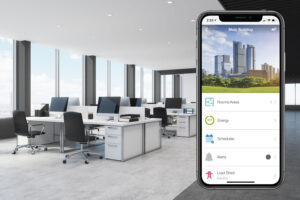The good news is the construction outlook is strong and contractors are busier than ever. They also are still facing significant market challenges including ongoing supply chain disruptions, a persistent shortage of![]() skilled labor, changes to building codes and standards, and increased operating costs. And their customers are looking for solutions that not only keep projects on time and on budget but offer assurances that their building systems meet today’s needs and are flexible enough to adapt to whatever tomorrow brings.
skilled labor, changes to building codes and standards, and increased operating costs. And their customers are looking for solutions that not only keep projects on time and on budget but offer assurances that their building systems meet today’s needs and are flexible enough to adapt to whatever tomorrow brings.
All these factors make the contractor’s job more demanding. When it comes to lighting control, contractors are looking for solutions that make jobs easier, faster, and more future proof, add value, minimize callbacks, and ultimately give the customers what they want. Let’s look at five ways smart, wireless lighting control solutions can be a critical asset to your projects, your business, and your customers.
- Labor shortages and the volatile supply chain are not going away any time soon. Wireless lighting control can help you manage labor issues while meeting your design needs, helping to decrease risk, and protect profit margins.
In the latest U.S. Chamber of Commerce Commercial Construction Index (CCI), 88% of contractors report a high-to-moderate level of difficulty in finding skilled labor, and 35% of contractors said they turned down commercial projects because of the worker shortage. Wireless lighting control can help contractors get more done with their current staff, stay on schedule, and deliver within budget.
Why wireless? As shown in the following project example, wireless systems typically feature lower labor and material costs which can be passed on to the customer without reducing profit margins.
Example Project (Wired vs. Wireless): LED Retrofit in a 6,000 sq. ft. Office and Lab
| Wired Solution | Wireless Solution* | |
| TOTAL BID | $70,000 | $60,000 |
| Labor and overhead costs | $35,000 | $27,000 |
| Material costs | $30,000 | $18,000 |
| PROFIT | $ 6,000 | $15,000 |
*Actual project shown is a wired solution compared to a Lutron Vive wireless solution. Total cost for the entire project includes the cost of materials including the LED fixtures and controls with the associated labor and overhead costs to complete the project.
Especially in retrofits, there is minimal need to open walls or pull new wire. With wireless, it is also easier to add or adjust sensors, controls, and even smart hubs at any time during project design or installation without significantly impacting the project budget or schedule. You can do more with the team you have, and changes are not a big issue.
In general, wireless systems are comprised of standard stocked components. They also typically use less conduit and wiring, and fewer wall boxes, J-boxes, and power supplies than wired systems. The result is lower material and labor cost, and lower supply chain risk. In the second quarter of 2021, just under half of surveyed respondents (46%) said unreliable product availability was their top concern, according to the U.S. Chamber of Commerce’s Commercial Construction Q2 2021 report. While no one has a crystal ball to predict stock status, a system designed with less material is a good strategy for minimizing supply chain concerns.
- The workplace is changing, and customers want assurances that the lighting can adapt moving forward.
Building owners and facility managers recognize that their offices look different than they did just a few years ago – hybrid schedules, hoteling, more open space, variable occupancy rates – these are now commonplace project considerations. The lighting control must quickly and seamlessly respond to changing occupant patterns. Installing flexible, scalable lighting control solutions will allow building owners to enhance their space utilization and maximize their profitability.
their space utilization and maximize their profitability.
For example, as employees return to in-person schedules, wireless lighting controls provide adaptability. Electrical contractors can install lighting on one floor today and then return to easily expand the system to quickly get three more floors up and running. And wireless control gives employers enhanced flexibility as well – reconfigure space from a convenient app to give an employee a personal office with individual lighting control or redesign the open office layout with no new wiring. Wireless helps to ensure more flexible and future-proof space with sensors and controls that are easy to add, relocate, and reprogram when space layouts change, or an area is subdivided.
- Automated, contactless control is moving from a “nice perk” to a “must have.”
Contactless lighting controls are one way to minimize high-touch surfaces and give employees greater control over their personal environment. With the Center for Disease Control and Prevention (CDC) encouraging businesses to clean frequently touched areas at least once a day, touchless controls also can help relieve some of the stress on the facilities team.
In a 2020 survey, 62% of electrical contractors said they were asked “all the time” or “sometimes” about providing hands-free or touchless control options. Occupancy and daylight sensors are often required by code. Wireless sensors can be installed in about 15 minutes at minimal cost and programmed remotely via a smartphone app.
- With new products and technologies comes an increased demand for training and education.
For many contractors, wireless lighting control is still a relatively new project solution. Fortunately, many wireless systems are easy to install, program, and expand over time. Work with manufacturers that offer convenient, accessible training to help you stay up to date on new products, new software, and current codes and standards. Look for providers that offer online training – both live and on-demand courses – that can be accessed on your own terms, your own time, and your own schedule. Online learning can make it easier to refer back to specific parts of the training based on individual areas of interest, or what a current job requires. Training classes that used to take two to three days in person can be completed virtually in two to three hours at a comfortable pace.
Manufacturer-based training is also a key resource for quickly bringing skilled laborers up to speed on the latest technologies, system installation, and programming. Continuing education and training are critical to ensuring contractors are equipped with the tools and software they need to make jobs easier and more profitable, and to build long-term value with the customer.
- Smart, connected, wireless control enables contractors to have more autonomous control over the installation and program of the lighting control on their projects, but services and support are often still essential to a seamless installation and a satisfied customer.
As advanced technology, wireless capabilities, and user-friendly solutions converge, a committed service and support team can help contractors navigate new paradigms. Choose reputable manufacturers with a proven track record for delivering quality products and services from the beginning of a job to the end of it, no matter the size of the project.
Beyond product functionality and performance, carefully evaluate the lighting systems and manufacturers you choose. Ask key questions about how well their wireless and other solutions have stood the test of time, how easily their systems adjust to changing needs, and how well they help engineers support code in their designs. Does the solution have a reliable, well-vetted, tested system architecture? Is it capable of successfully integrating with other systems in the building? Are system components readily available at your local distributor for rapid deployment to the site?
Before you finalize your system choice, be confident you have set yourself, and your client, up for long-term success. The building systems you install should be able to meet the immediate needs of the space and its occupants and be designed for seamless integration with tomorrow’s technologies as well.
While building trends come and go, lighting impacts every part of your projects. The bottom line going forward is that with so many options to choose from, wireless lighting control offers both you and the customers options that are flexible, scalable, and forward-focused.


